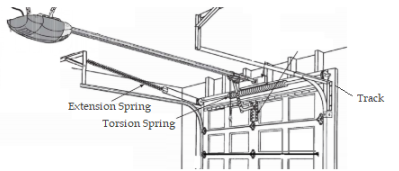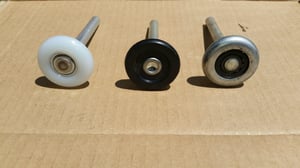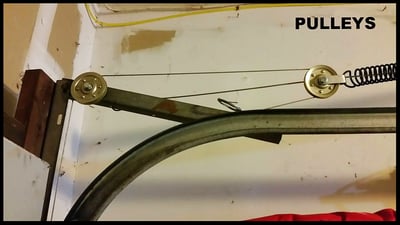As with most mechanical items, there are many components associated with your garage door and garage door opener system. At Overhead Door Co. of Central Jersey, we often find our customers looking for the ‘right words' to describe a component of their garage door that might be broken or affecting the proper operation of the system.
While the number of individual parts can be significant, there are some general terms that are useful when calling in for service. Knowing these few key terms will help our service department understand what problem you may be having with your system. Let’s take a look at a few of the major components of a typical garage door system.
 Extension Spring, Torsion Spring & Track
Extension Spring, Torsion Spring & Track
- Extension spring: Often called a stretch spring. This spring is suspended above the horizontal track and is controlled by a lift cable that extends the spring as the door is lowered.
- Torsion spring: This spring is mounted above the front of the garage door on a pipe or shaft. This shaft will also have the cable drums mounted on it. A torsion spring is wound around the pipe or shaft to create the torque required to counterbalance the door weight.
- Garage Door Track: Often called rails. The track is the component that is bolted to the wall and suspended from the ceiling for the door to ride in as it travels up and down. The track consists of two major pieces: The vertical piece (attached to the wall on each side of the door) and the horizontal piece (the piece the door rests in when in the open position). If you have a damaged track, it is helpful for you to tell us it is the left or right side (as viewed from the inside looking out) and if it is the vertical or horizontal piece.
- Sections: Residential doors typically consist of three, four, or five sections. Customers often refer to the sections as panels. In the garage door world, a panel is a piece inserted into a frame as a part of a section, normally on an older door of wood construction. Therefore, an older wooden door may have four panels in one section. On a steel or composite door, the section may or may not have panels. These panels are stamped into the steel as a part of the section design. In this case, the face of the section is one piece rather than an assembly. To describe a typical door design you might say ‘my new garage door is a one-car door with four panels on each section’.
- Hinges: Obvious enough, these are the components that join the sections together and fold as the door moves through the curved portion of the track. There are end hinges and center hinges. Each section of the door has a specific hinge on the ends, while all the center hinges are alike. If you have a damaged hinge it is important to tell which section it is on. For example, ‘the hinge on the top of the second section appears to be broken on the left side looking out’. It is also important to note that different manufacturers may use different hinge systems. These cannot be mixed.

- Top fixture: This is the bracket mounted on each side of the top section of the door. These fixtures, or brackets, come in a variety of styles. Some are adjustable, some are not. Like hinges, there is not a left or right, both are the same.
- Wall console: This is the pushbutton device mounted inside the garage, normally next to the door leading from the home to the garage. Most modern opener systems have multi-function wall consoles. These units typically allow the user to operate the door system, turn the unit-mounted lighting on or off without moving the door and lock out the radio controls so they will not work. Some premium units also offer time, temperature and, floor level programming and other features.

Wall Console
- Bottom fixture: This is the bracket mounted on the lower corner of the very bottom section of the door. These fixtures hold the lift cable and they are under extreme tension. Under no circumstance should these fixtures be removed by a person that is not qualified to work on the spring counterbalance of the door. There are many different types of bottom fixtures. It is also important to know if you need a left-hand or right-hand fixture, these are specific for the side of the door they are mounted on.
- Roller: Often called wheels. These insert into the bottom fixtures, each end hinge, the top fixtures, and into the track, allowing the door to roll easily in the track assembly. Rollers come in many varieties as well. There are rollers with steel tires, with plastic or nylon tires, with ball bearings, without ball bearings, and so on.

- Pulley: Mounted on the top corners of the track assembly when the door is balanced with extension springs. There is also a pulley on one end of each extension spring.
- Drum or Cable Drum: Often called a spool. This component is used on a door that is balanced with a torsion spring system and mounts above the door on each side. There is a left and right-hand drum.
- Lift cable: This cable is attached to the bottom fixture on each side of the door and routed either over the pulleys to extend an extension spring. On a door that uses a torsion spring, this cable would be routed to the cable drums to roll up and pay out the cable as the door moves up and down.
- Safety or retaining cable: This cable is used only with extension spring counterbalance systems. It is routed through the center of the spring and attached at each end so the spring will be contained in the event of a failed spring, lift cable or pulley.
 Retaining Cable
Retaining Cable
While there are many other components, these terms will help you describe the most common service items. Now let’s take a look at some of the language associated with garage door opener systems.
→ Suggested Lecture: My Garage Door Cable Broke, Now What? ←
- Remote control: This is the handheld device that activates the opener system. Often called a remote, a clicker, a transmitter, or a button. Today many vehicles have built-in remote control systems that can replace the need for you to carry a separate device. You will still need the remote control provided with the opener system to program any system that is in your vehicle.

3 Button Remote Control Master Remote Control
- Opener: Normally, this would refer to the entire ‘automatic garage door opener system’. Often we receive calls asking questions about an ‘opener’ to find out the caller is actually referring to the handheld remote control.
- Keyless entry, wireless keypad or digital access control: This is the device mounted on the outside of the door opening allowing you to open the door with a keyed-in numeric or alpha-numeric code. Many can be set to work multiple door systems. Most of these devices are wireless and battery-operated. They are very secure and offer a convenient way into the garage when you are not in your vehicle.
- Photocell or safety beam: You will find these mounted near the bottom of your door track on each side of the door, normally within six inches of the floor. The photocell completes the circuit allowing the automatic door to operate. If something blocks the light from the photocell or if the photocell malfunctions the opener will typically only work from the inside wall console while holding the button in. If the door is closing and the light beam is interrupted, the door will reverse to the full open position until the blockage is cleared.
- Circuit board or control board: This component is the brain of the operation. It receives all of the commands from the remote control, the wall console, the keyless entry, and the photocells.
As with a garage door, there are many additional components that complete your automatic garage door opener system. The items mentioned here are some of the most commonly discussed during a call for parts or service.
While we hope it has been helpful to gain a bit of an understanding of the parts associated with your garage door, we want to remind you the door system is under extreme spring tension and should not be serviced by anyone that is unfamiliar and unqualified to work on the system.
Also, if you are trying to source a part or if you would like to describe a part to us when placing a service call, it can be extremely helpful to take a photo and be prepared to email or text it to one of our service coordinators for easy identification.
At Overhead Door Co. of Central Jersey, we have been selling, installing, and servicing garage door systems since 1972 – for 47 years.
We look forward to assisting you with any garage door requirements you may have. We are conveniently located at 952 Route 202 South and River Road in Branchburg, NJ. We can be reached at 908-722-5785 and we are on the web at www.OverheadDoorCo.Com.















